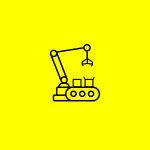Robotic Process Automation: The highlights reel

Our brand new book, Working Machines – An Executive’s Guide to AI and Intelligent Automation has just hit the shelves. If you’d like to learn more about how AI can improve your business you can purchase it from Amazon, Google Books or Apple Books. Also available in audio on Audible. It’s time to welcome your new no-collar workforce into your business.
Following on with our RPA deep dive, this week we’re looking at who’s adopting RPA, where it is most popular and of course who the main players are. The field is growing by the moment and early adopters and new kids on the block alike all have interesting perspectives on how to do RPA right. Certain business sectors have already seen how including AI in their process management is the sensible way to go. When talking regionally, RPA is most prevalently used in North America with the Asia Pacific pitted to outperform in the adoption of RPA heading into 2020. Here’s the DL on RPA as we head into the next decade.
Who uses RPA now and why?
According to various studies, healthcare and the pharmaceutical industry is expected to grow highest in compound annual growth. However, currently it seems that the banking and financial industry account for the largest early adoption of RPA. As we’ve mentioned previously, one of the key driving factors for RPA investment is the vertex between high efficiency and cost reduction and by all accounts, tools hold the largest market share within the RPA offering. The next two RPA types are services and travel and logistics.
Where in the world?
There are a number of studies going on at the moment trying to understand how far RPA has managed to infiltrate various regions. As it stands, North America accounts for the largest share in the RPA market while unsurprisingly Europe is also one of the prominent players. Interestingly, countries such as U.K., Germany and Italy are the major contributors to the market growth due to their rich manufacturing and automotive industries. However, it should be noted that bets are on Asia-Pacific to emerge as the fastest-growing market going into the next forecast period running into 2020. The demand for consumer electronic products in Asia continues to grow and is forcing the manufacturers to adopt cost-effective technologies in their manufacturing process and by all indications, RPA seems like the best possible solution.
Who’s who in the RPA game
According to a 2017 report by Forrester Wave, there are some RPA vendors that are a cut above the rest. They list Automation Anywhere as the ‘top dog’ followed closely by Blue Prism and UiPath.
1. Automation Anywhere
Automation Anywhere (AA) is currently number one, holding the largest market share in RPA. They deliver well with their enterprise-grade digital workforce platform. From the get-go, AA’s primary targets have been shared services like ‘procure-to-pay, quote-to-cash, human resources administration, claims processing, and other back-office processes’. AA’s current work split is 90% back office and 10% front office. They also have the largest trained ecosystem, approaching 10,000 For Enterprise Architecture Professionals. Stacking up well with great R&D prospects AA is also the largest RPA provider from a revenue standpoint.
While they do have great market momentum they do have a few chinks in their armour where others are innovating better. First and foremost there is a need for programming skills to design the robots and their overall usability is questionable. Their ‘out-of-the-box’ solutions are not as effective as they could be. Falling short specifically around dashboard builds and while it includes extensive audit detail making the data useful is a bit of an effort.
2. Blue Prism
Coming in as a close second is Blue Prism. They’re considered to be real innovators and have an incredibly forward-thinking approach to RPA (given that this technology is already cutting edge that’s saying something). Starting out as early as 2001 a group of process automation experts could clearly see what many have only really started to realise in the last 48 months or so. ‘Secure, scalable, and central management of a virtual workforce of software robots in regulated industries is the company’s focus.’ They have chosen to have a strong partner focus acquiring 80% of their revenue from license fees. ‘Blue Prism offers an end-to-end process view that results in work distribution and queue management strength. Central control of all RPA functions is well suited to its regulated industry focus. The solution has strong load balancing, restart functionality, encryption at rest, and audit, as well as desktop-aligned robots that are defined and managed centrally.’
While they have a very clear idea of what they do and how they do it, there are still a few concerns around the design studio’s usability. In the recent past, they have stagnated on some projects because of struggles related to partners not being able to keep up with proof-of-concept. Having some experts say that they’ll need strong analytics to assist them in keeping the title of most innovative in RPA.
3. UiPath
UiPath is a Romanian company, founded in 2005. They provide an open platform well suited for complex automation, which is becoming more and more necessary as the ideas get as big as expectations. The main focus of their software products is to eradicate tedious, redundant tasks with robots. As a vendor they have taken a very open approach that has been well received, opting to appeal to integration partners and savvy end-users who are interested in extending robotic automation by using standard scripting and programming environments. ‘The design studio is based on Microsoft’s Workflow Foundation, and the NuGet version control is packaged with the product. Reporting capabilities use open-source Elasticsearch for data gathering and Kibana for visualization.’ All in all their solution has really great architecture.
There is a requirement for better cognitive capabilities ‘to parse unstructured data and integrate natural language processing and chatbots, so as to not fall behind competitors.’ though. Despite the need for improved work distribution and scheduling, UiPath is definitely one of the stronger RPA platforms.
The runners-up
WorkFusion and Pegasystems are both working their way towards the top spot. Workfusion specializes in conversational understanding to improve how people interact with machines, which puts them closer to the front seat with a user first culture. Pegasystems, on the other hand, merge robots, analytics and case management. That enterprises are still not sure how RPA fits with their process tools remains a fact and taking this into consideration Pegasystems is the first and only BPM market participant of substance to purchase an RPA provider (OpenSpan). ‘The newest release of Pega Robotics combines OpenSpan with a limited-use license for Pegaystems’ case management and BPM products, which now come with an RPA purchase.’
All in all, this is an incredibly exciting time for AI and RPA specifically. What is particularly interesting is how each vendor in the field has adopted their own unique path to market, which proves that there is no one ‘right’ way to do RPA and that comes down to the most important factor of all… what’s right is all dependent on the humans that need to use it.
Mario Grunitz
Working Machines
An executive’s guide to AI and Intelligent Automation. Working Machines takes a look at how the renewed vigour for the development of Artificial Intelligence and Intelligent Automation technology has begun to change how businesses operate.







